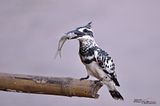
Not only the regal group of birds, the cranes, that dominates most of the area in Arasaki, I surprisingly found that the number of Corvus was also spectacular. Even though I've been living in Japan for almost a year now, and became quite familiar with the abundance of crows, but when I first saw the flock of Rooks in Arasaki, I could say that it was a surprise.
 An adult Rook in flight
An adult Rook in flight I'm not sure about where they came from, but they are different from the ones that found in Europe. Japanese Rooks are Corvus frugilegus pastinator while the ones in Europe are Corvus frugilegus frugilegus. The bare part on their faces are different. The European one has more bare part from bill base to throat, while the Japanese subspecies has only bare bill base. I think the Japanese ones also look smaller, may be because of the shape of their heads. Anyway, both of them have the same pointed, cone-shaped bill, which is the easiest way to identify them from other corvus.
 The juvenile bird has black feathers on bill base.
The juvenile bird has black feathers on bill base.
The juvenile Rooks can sometimes be confusing. They have black feathers on their bill bases, which make them look like the other kinds of corvus, especially the Carrion Crow, but anyway, with their sharp bills, we can still be able to distinguish them.
 Rooks feeding in the rice field
Rooks feeding in the rice fieldActually, Rooks are not widespread in Japan. They are mainly restricted to Kyushu Island, the southernmost main island of Japan. Not only at Arasaki that I have seen huge flocks of Rooks, but I've also seen some other flocks from the train along the way back to Beppu. Sometimes there are other species of crows joining the flock. For example, the one I missed, the rare Daurian Jackdaw. The much more common ones like Large-billed and Carrion Crows are usually found mixing with the group also. Overall, to me, I think it's quite enjoyable watching these common, black birds carefully. They always have some interesting details just like the colorful ones!
 Like other crows, Rooks also have bluish eyelid
Like other crows, Rooks also have bluish eyelid 
This one was doing something, which I think, a 'display'
 They perched on electronic wires in group.
They perched on electronic wires in group.










.jpg)

No comments:
Post a Comment